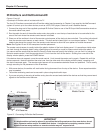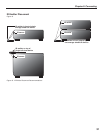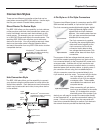
Chapter 2: Connecting
33
4-Pin Style vs. 6-Pin Style Connectors
There are two different types of connectors used for IEEE
1394 terminals and cables, a 4-pin and a 6-pin style.
The 4-pin connector sends digital audio signals, digital
video signals and digital control
signals back and forth between
devices. Your media center has two
(2) 4-pin type connection terminals
available on the rear panel.
The 6-pin connector is capable
of sending the same digital audio,
video and control signals as the
4-pin connector, but the 6-pin
connector is also able to send
low voltage electrical power. This
media center does not have 6 pin
connectors.
The purpose of this low voltage electrical power is to
provide the needed operating power to a device that is
not connected directly to the household AC power such
as a camcorder. A device with a 6-pin connector can
send this electrical power to another device, or receive
electrical power from another device, or simply use a 6-
pin connector without using the two additional pins.
A 6-pin connector cannot be connected directly to a
4-pin terminal, and vice versa. To connect a 6-pin device
to a 4-pin device, you will need
to obtain a 6-pin to 4-pin adaptor
or adaptor cable. These cables
are available from electronic and
computer stores.
When connecting a 6-pin device
(such as a camcorder) to the media
center, (if it is designed to receive
electrical power from another 6-pin
device) you will need to connect the camcorder directly
to the household AC, or use the camcorder’s battery for
power. If this is not possible, then the camcorder will
need to be connected directly to another 6-pin device in
the network that can provide the electrical power.
QJOUPQJOBEBQUPS
4 pin connector
6 pin connector
Direct Device-To-Device Style
The IEEE 1394 offers you the capability to chain devices,
unlike previous audio and video connections where you
had to individually connect each device directly to the
media center. For example, you can connect a D-VHS
to a 1394 DVD Player and then to the media center. The
resulting IEEE 1394 chain will allow you to add more
devices to the chain. You will be able to see each video
device on the media center’s Device Selection Menu
and send information from any IEEE 1394 device to other
compatible devices.
Hub Connection Style
The IEEE 1394 also offers you the capability to connect
your devices using the media center as a hub within the
audio/video network. Each device can send information,
which may include audio and video, to any other device
in the network.
%JHJUBM
%7%
%JHJUBM
7$3
%JTQMBZ
.FEJB$FOUFS
.POJUPS-JOL
5.
$POUSPM34$
BOE%JHJUBM"7DBCMFTDPOOFDUJOH
.FEJB$FOUFSUP%JTQMBZ
%JHJUBM
%7%
%JHJUBM
7$3
%
*
(
*
5
"
-
%
*
(
*
5
"
-
4
6
3
3
0
6
/
%
4
6
3
3
0
6
/
%
4
$)
$)
%JHJUBM%7%
%JHJUBM7$3
0UIFS%FWJDF
%JHJUBM
7$3
0UIFS
%FWJDF
%JTQMBZ
.FEJB$FOUFS
.POJUPS-JOL
5.
$POUSPM34$
BOE%JHJUBM"7DBCMFTDPOOFDUJOH
.FEJB$FOUFSUP%JTQMBZ
Connection Styles
There are two different connection styles that can be
used when connecting IEEE 1394 devices. Use the style
that fits your network of audio/video products.


















